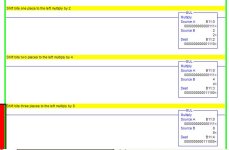We are working on a project in class, so far we have only the basic commands, user, timers, as well as some math-compare instructions.
We're using the micrologix 1000 plc.
We have already wired up a powerflex 40 using relays to start a motor going forward on O:0/0, then backwards on O:0/1. Also we have the speed preset controls set up on O:0/3, O:0/4, and O:0/5.
So far so good.
Now we're suposed to run the motor one dirrection, change speed several times, reverse the motor, and change speeds several times again, and start over. Things like stop, start, acceleration, and deceleration are not required.
I've been looking at some of the traffic light programs, and thinking I could just modify the "lights" to be motor speeds, and write the needed outputs for each speed in paralell on seperate lines.
Nothing I have come up with seems very proper to me. I might be able to make it work, but I think I could do better than that.
Any suggestions on how to plan this thing out, and start putting something like this together?
We're using the micrologix 1000 plc.
We have already wired up a powerflex 40 using relays to start a motor going forward on O:0/0, then backwards on O:0/1. Also we have the speed preset controls set up on O:0/3, O:0/4, and O:0/5.
So far so good.
Now we're suposed to run the motor one dirrection, change speed several times, reverse the motor, and change speeds several times again, and start over. Things like stop, start, acceleration, and deceleration are not required.
I've been looking at some of the traffic light programs, and thinking I could just modify the "lights" to be motor speeds, and write the needed outputs for each speed in paralell on seperate lines.
Nothing I have come up with seems very proper to me. I might be able to make it work, but I think I could do better than that.
Any suggestions on how to plan this thing out, and start putting something like this together?




